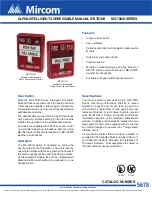
19
A Distributed Microphone is used between audio nodes in a network system where each node has
its own local audio (its own Digital Audio Controller) but needs to be able to play the microphone
channel from a separate node’s Digital Audio Controller.
For a distributed microphone application, the 4100-0622 Digital Riser Interface (566-407) has a
single digital to analog converter that can be set to convert any single channel of the Digital Audio
Riser (DAR) stream to analog. This analog output is connected to a second Digital Audio
Controller’s remote microphone input or to the microphone input of a 4100-1240 Input Option
Card (566-037). DIP switches configure the channel selection and density.
Figure 12 is an illustration of the distributed microphone application wiring. Refer to the Switches
and Indicators section for switch settings to configure the distributed microphone channel output.
Figure 12. Distributed Microphone Interconnections
Continued on next page
Wiring,
Continued
Distributed
Microphone
Interconnections
Notes:
1.
All wiring is 24 AWG (0.2047 mm
2
) to 18 AWG (0.8321 mm
2
), twisted pair.
2.
Maximum distance between subsequent nodes: 2,500 feet (762 meters).
3.
Maximum line resistance and capacitance between nodes:
18 AWG (0.8321 mm
2
): 40 Ohms maximum,
0.055
μ
F maximum
24 AWG (0.2047 mm
2
): 135 Ohms maximum,
0.055
μ
F maximum
4.
All wiring that leaves the building requires the 2081-9044 Overvoltage
Protector at each entry or exit to the building. A maximum of four
overvoltage protectors are allowed. Each 2081-9044 adds 6 Ohms and
0.006
μ
F.
5.
Wiring must be free of all grounds.
6.
Audio wiring is not to be mixed in the same jacket with other wiring
(including other audio wiring).
7.
You also can connect the Mic Input to Input 4 (TB1-11 & TB1-12) instead
of Input 3 (TB1-7 & 1-8). (Connection to Input 3 is shown.)
8.
Connects to either Option Card or Controller (one of these two wires).
9.
When using the Option Card for a Distributed Microphone application, you
must configure the card for a microphone level input. See the Option Card
manual (579-160) for details.
10. Typically, the Master Microphone is located in Node 1 but could be in a
different node depending on the application.
11. Basic TIC is 4100-0620 (566-093); Local Mode TIC is 4100-0625
(566-094); and Network Audio Riser Controller Module is 4100-0623
(566-249).
firealarmresources.com
































